Abstract
Nonionic diffusion and diffusion equilibrium of ammonia have been generally accepted as the mechanism of urinary ammonium excretion. However, these characteristics have not been examined directly in vitro. In the present studies, nonionic diffusion and diffusion equilibrium of ammonia were examined in rabbit cortical collecting tubules perfused in vitro. Collected fluid ammonium and pH were measured in tubules exposed to chemical gradients of NH3/NH+4. In tubules perfused with an acid perfusate free of ammonia and bathed with solutions containing NH4Cl, collected fluid ammonia failed to equilibrate across the epithelium except at slow flow rates. The estimated apparent permeability coefficient to NH3 was approximately 5 X 10(-3) cm/s. Predominant nonionic diffusion of NH3, rather than transport of NH+4, was indicated by alkalinization of luminal fluid in tubules exposed to peritubular NH4Cl and by the relative influence of peritubular NH+4 and NH3 on ammonia entry. In tubules perfused with an acid solution containing NH4Cl, little loss of ammonium was detectable, indicating a low permeability to NH+4. In contrast to the restricted diffusion of NH3 in cortical collecting tubules, proximal convoluted tubules exhibited a much higher apparent permeability to NH3. In conclusion, nonionic diffusion of NH3 accounted for most ammonium transport in the proximal convoluted tubule and in the cortical collecting tubule. However, there was relatively restricted diffusion in the collecting tubules; this may account for the failure of whole kidney ammonium excretion to obey quantitatively the predictions of nonionic diffusion and diffusion equilibrium of ammonia.
Full text
PDF
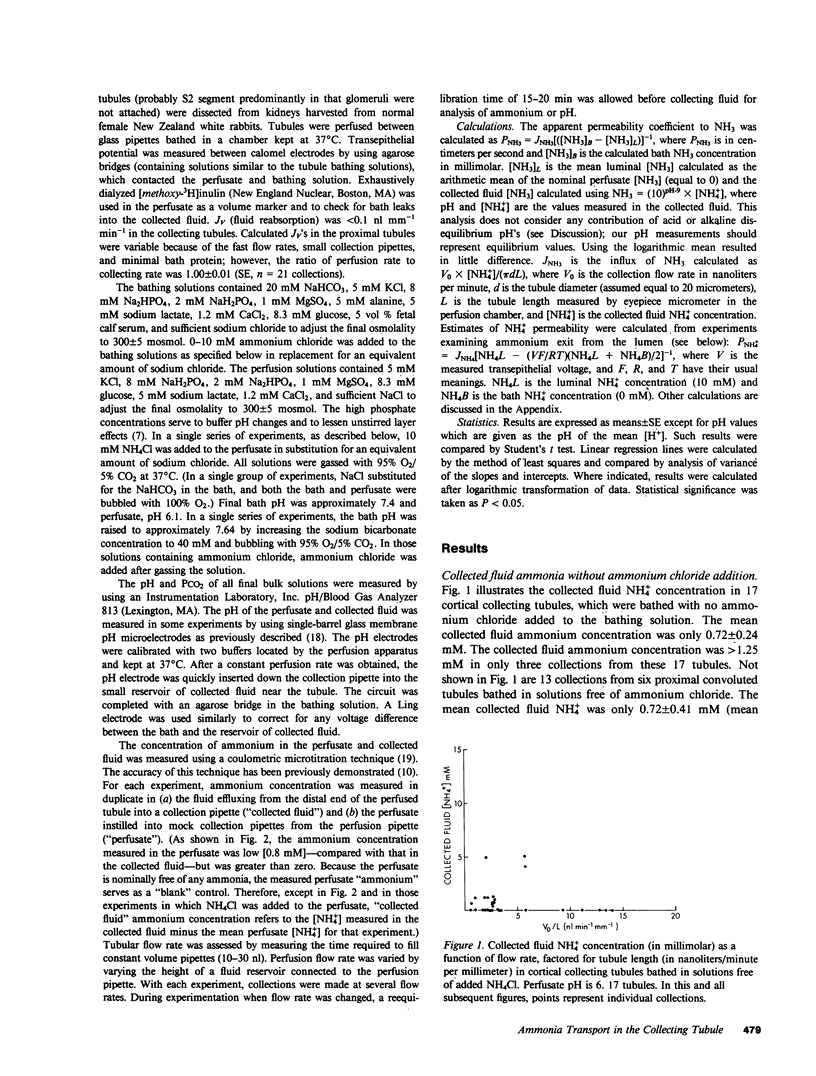
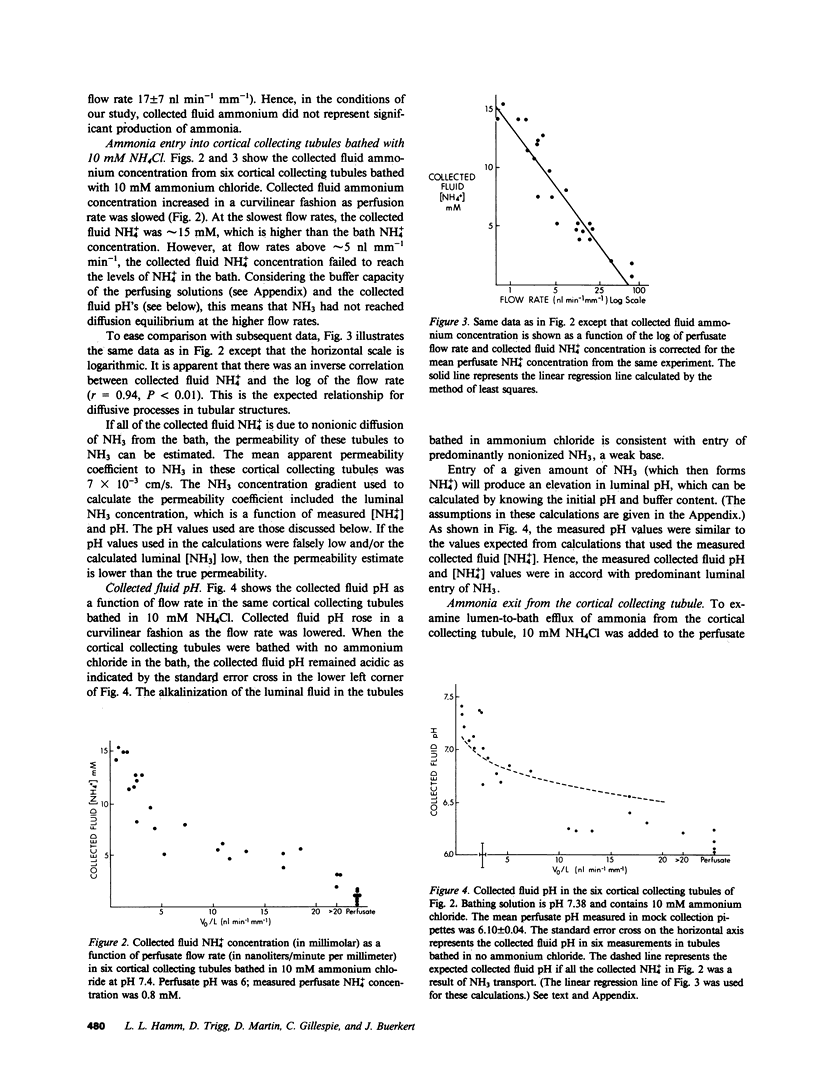
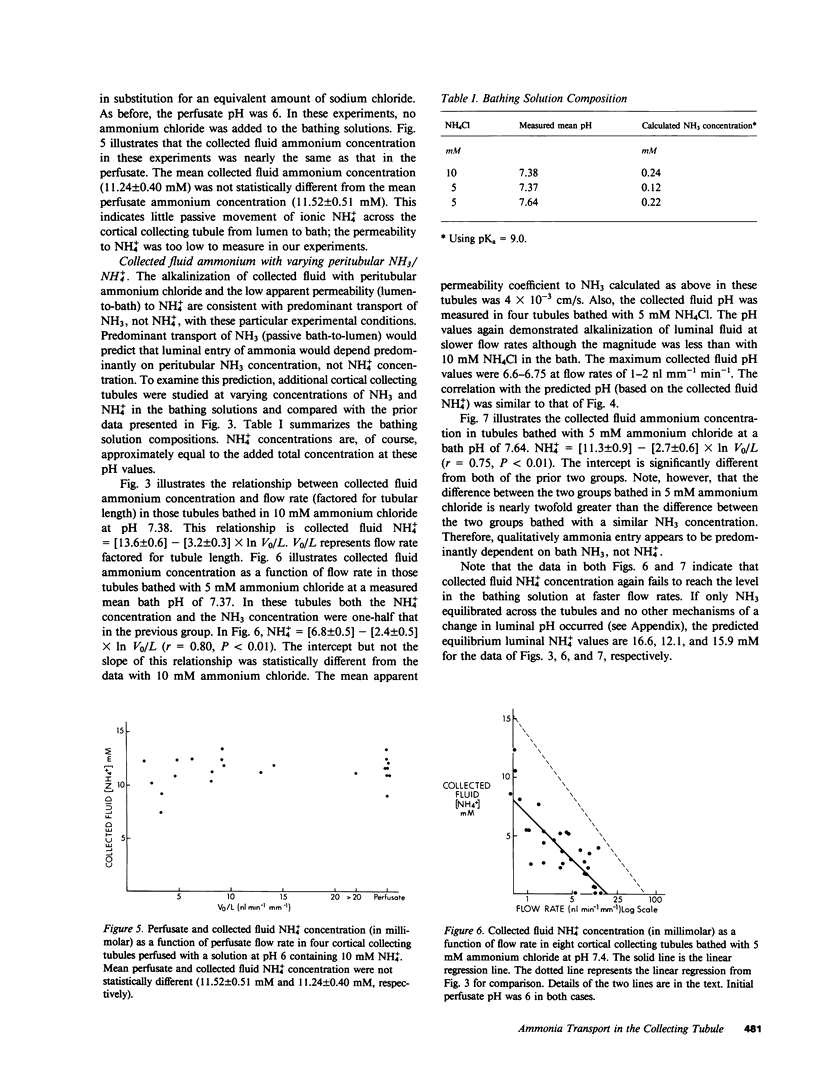
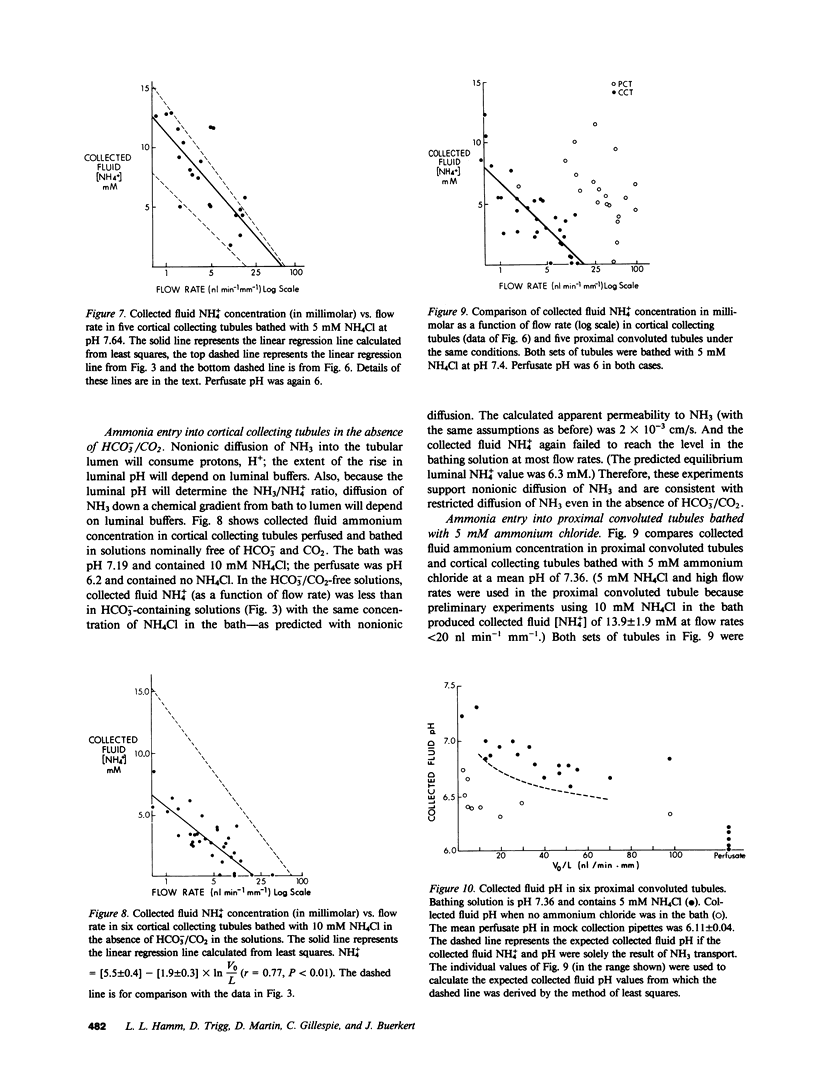
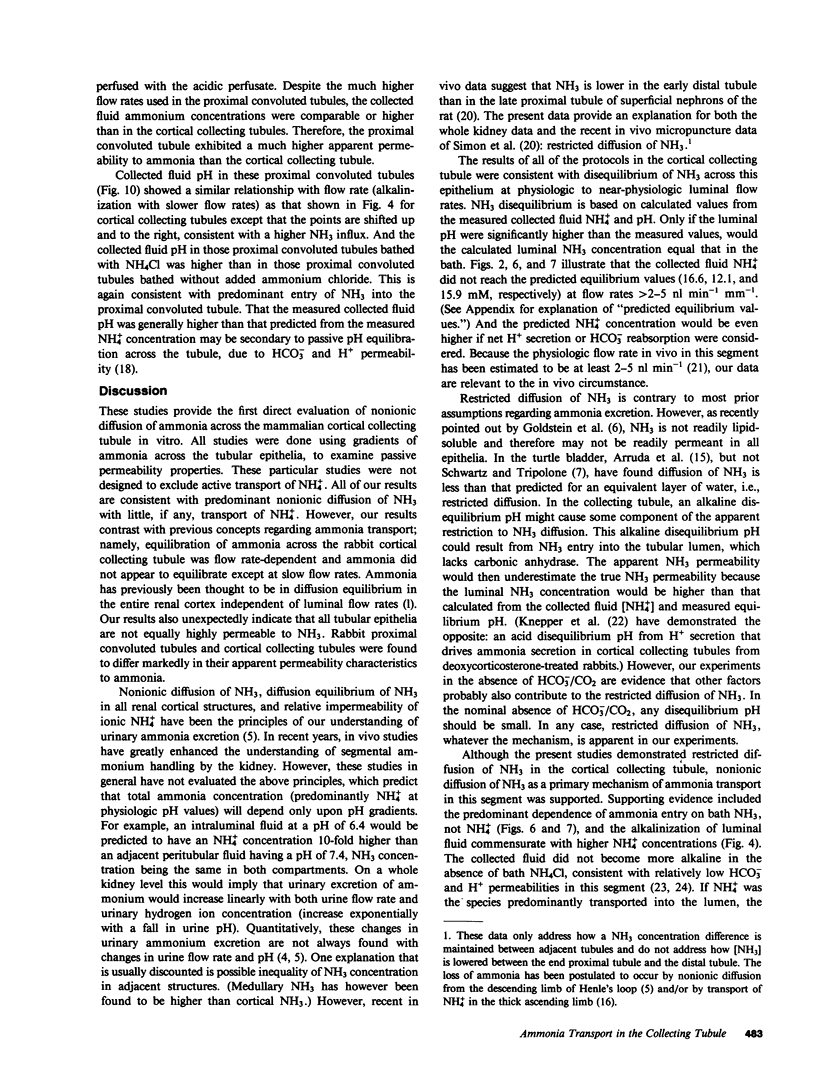
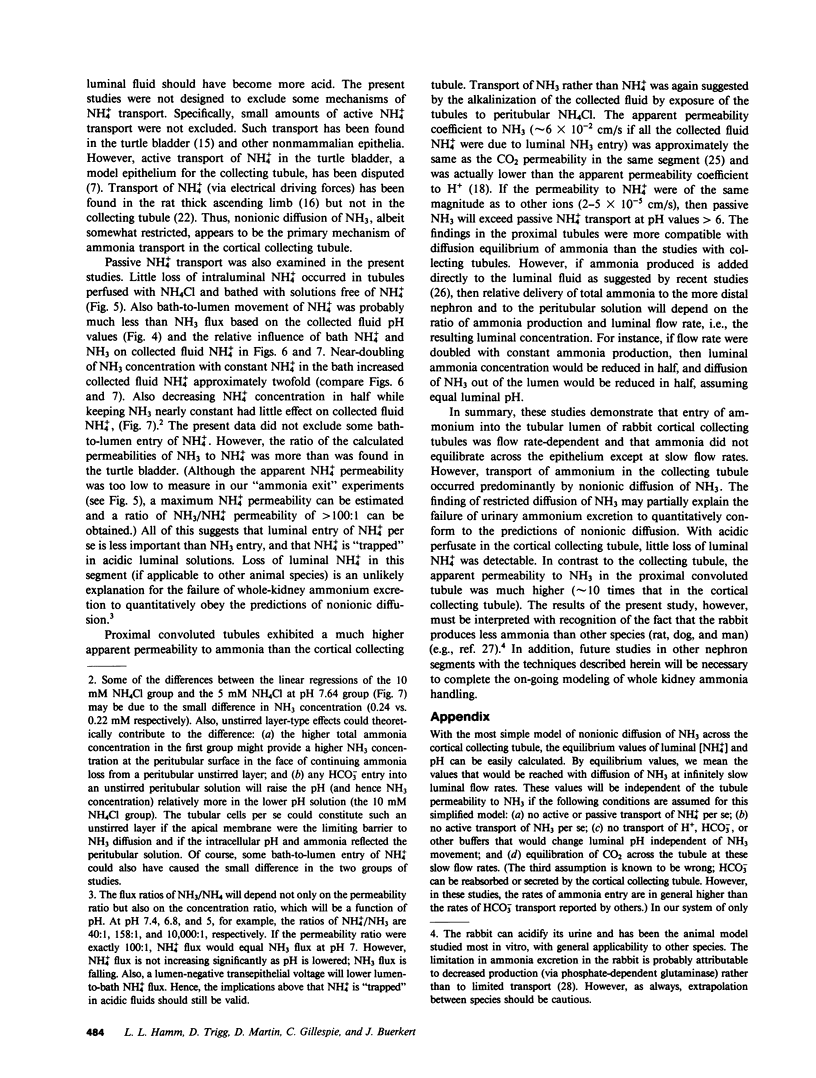
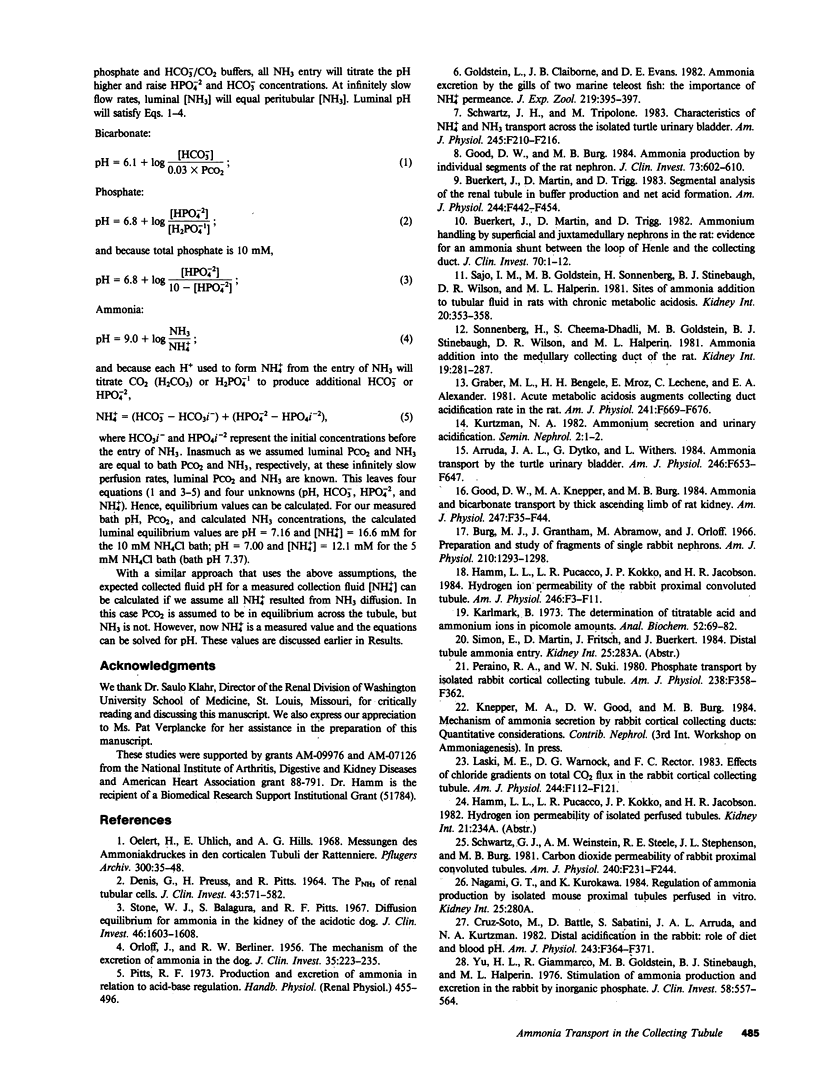
Selected References
These references are in PubMed. This may not be the complete list of references from this article.
- Arruda J. A., Dytko G., Withers L. Ammonia transport by the turtle urinary bladder. Am J Physiol. 1984 May;246(5 Pt 2):F635–F647. doi: 10.1152/ajprenal.1984.246.5.F635. [DOI] [PubMed] [Google Scholar]
- Buerkert J., Martin D., Trigg D. Ammonium handling by superficial and juxtamedullary nephrons in the rat. Evidence for an ammonia shunt between the loop of Henle and the collecting duct. J Clin Invest. 1982 Jul;70(1):1–12. doi: 10.1172/JCI110581. [DOI] [PMC free article] [PubMed] [Google Scholar]
- Buerkert J., Martin D., Trigg D. Segmental analysis of the renal tubule in buffer production and net acid formation. Am J Physiol. 1983 Apr;244(4):F442–F454. doi: 10.1152/ajprenal.1983.244.4.F442. [DOI] [PubMed] [Google Scholar]
- Burg M., Grantham J., Abramow M., Orloff J. Preparation and study of fragments of single rabbit nephrons. Am J Physiol. 1966 Jun;210(6):1293–1298. doi: 10.1152/ajplegacy.1966.210.6.1293. [DOI] [PubMed] [Google Scholar]
- Cruz-Soto M., Batlle D., Sabatini S., Arruda J. A., Kurtzman N. A. Distal acidification in the rabbit: role of diet and blood pH. Am J Physiol. 1982 Oct;243(4):F364–F371. doi: 10.1152/ajprenal.1982.243.4.F364. [DOI] [PubMed] [Google Scholar]
- DENIS G., PREUSS H., PITTS R. THE PNH3 OF RENAL TUBULAR CELLS. J Clin Invest. 1964 Apr;43:571–582. doi: 10.1172/JCI104942. [DOI] [PMC free article] [PubMed] [Google Scholar]
- Goldstein L., Claiborne J. B., Evans D. E. Ammonia excretion by the gills of two marine teleost fish: the importance of NH4+ permeance. J Exp Zool. 1982 Feb 20;219(3):395–397. doi: 10.1002/jez.1402190317. [DOI] [PubMed] [Google Scholar]
- Good D. W., Burg M. B. Ammonia production by individual segments of the rat nephron. J Clin Invest. 1984 Mar;73(3):602–610. doi: 10.1172/JCI111250. [DOI] [PMC free article] [PubMed] [Google Scholar]
- Good D. W., Knepper M. A., Burg M. B. Ammonia and bicarbonate transport by thick ascending limb of rat kidney. Am J Physiol. 1984 Jul;247(1 Pt 2):F35–F44. doi: 10.1152/ajprenal.1984.247.1.F35. [DOI] [PubMed] [Google Scholar]
- Graber M. L., Bengele H. H., Mroz E., Lechene C., Alexander E. A. Acute metabolic acidosis augments collecting duct acidification rate in the rat. Am J Physiol. 1981 Dec;241(6):F669–F676. doi: 10.1152/ajprenal.1981.241.6.F669. [DOI] [PubMed] [Google Scholar]
- Karlmark B. The determination of titratable acid and ammonium ions in picomole amounts. Anal Biochem. 1973 Mar;52(1):69–82. doi: 10.1016/0003-2697(73)90332-1. [DOI] [PubMed] [Google Scholar]
- Laski M. E., Warnock D. G., Rector F. C., Jr Effects of chloride gradients on total CO2 flux in the rabbit cortical collecting tubule. Am J Physiol. 1983 Feb;244(2):F112–F121. doi: 10.1152/ajprenal.1983.244.2.F112. [DOI] [PubMed] [Google Scholar]
- ORLOFF J., BERLINER R. W. The mechanism of the excretion of ammonia in the dog. J Clin Invest. 1956 Feb;35(2):223–235. doi: 10.1172/JCI103267. [DOI] [PMC free article] [PubMed] [Google Scholar]
- Oelert H., Uhlich E., Hills A. G. Messungen des Ammoniakdruckes in den corticalen Tubuli der Rattenniere. Pflugers Arch Gesamte Physiol Menschen Tiere. 1968;300(1):35–48. [PubMed] [Google Scholar]
- Peraino R. A., Suki W. N. Phosphate transport by isolated rabbit cortical collecting tubule. Am J Physiol. 1980 May;238(5):F358–F362. doi: 10.1152/ajprenal.1980.238.5.F358. [DOI] [PubMed] [Google Scholar]
- Sajo I. M., Goldstein M. B., Sonnenberg H., Stinebaugh B. J., Wilson D. R., Halperin M. L. Sites of ammonia addition to tubular fluid in rats with chronic metabolic acidosis. Kidney Int. 1981 Sep;20(3):353–358. doi: 10.1038/ki.1981.146. [DOI] [PubMed] [Google Scholar]
- Schwartz G. J., Weinstein A. M., Steele R. E., Stephenson J. L., Burg M. B. Carbon dioxide permeability of rabbit proximal convoluted tubules. Am J Physiol. 1981 Mar;240(3):F231–F244. doi: 10.1152/ajprenal.1981.240.3.F231. [DOI] [PubMed] [Google Scholar]
- Schwartz J. H., Tripolone M. Characteristics of NH4+ and NH3 transport across the isolated turtle urinary bladder. Am J Physiol. 1983 Aug;245(2):F210–F216. doi: 10.1152/ajprenal.1983.245.2.F210. [DOI] [PubMed] [Google Scholar]
- Sonnenberg H., Cheema-Dhadli S., Goldstein M. B., Stinebaugh B. J., Wilson D. R., Halperin M. L. Ammonia addition into the medullary collecting duct of the rat. Kidney Int. 1981 Feb;19(2):281–287. doi: 10.1038/ki.1981.18. [DOI] [PubMed] [Google Scholar]
- Stone W. J., Balagura S., Pitts R. F. Diffusion equilibrium for ammonia in the kidney of the acidotic dog. J Clin Invest. 1967 Oct;46(10):1603–1608. doi: 10.1172/JCI105652. [DOI] [PMC free article] [PubMed] [Google Scholar]
- Yu H. L., Giammarco R., Goldstein M. B., Stinebaugh D. J., Halperin M. L. Stimulation of ammonia production and excretion in the rabbit by inorganic phosphate. Study of control mechanisms. J Clin Invest. 1976 Sep;58(3):557–564. doi: 10.1172/JCI108501. [DOI] [PMC free article] [PubMed] [Google Scholar]


